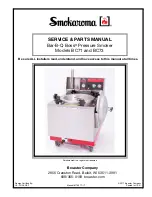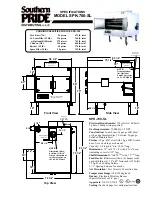SMOKE ALARMS
& HEAT ALARMS
A: GUIDANCE ON INSTALLATION
WARNING:
Wiring should be installed by a qualified electrician in accordance with BS7671.
Permanent connection to the fixed wiring of the building should be made in a suitable junction box.
This alarm must not be exposed to dripping or splashing. Connect the alarm as late as possible in
an installation, particularly in new build, to avoid contamination. Remove the dust cover before
applying power.
NOTE:
For detailed guidance on the siting of this alarm refer to section C of this handbook.
IMPORTANT:
The circuit used to power the alarm must be a 24 hour voltage circuit that cannot be
turned off by a switch. BS5839 Part 6 states that: -
For mains powered alarms, each with an integral standby supply (Grade D), the mains electricity
supply should take the form of either:
a) an independent circuit at the dwelling’s main circuit board, in which case no other electrical
equipment should be connected to this circuit (other than a dedicated monitoring device
installed to indicate failure of the mains electricity supply to the alarms); or
b) a separately electrically protected, regularly used local lighting circuit.
For mains powered alarms, with no standby supply (Grade E), the mains electricity supply may
only take the form of an independent circuit as per a) above. If it is necessary to use an RCD for
protection, it should operate independently of any RCD protection for circuits supplying sockets or
portable equipment.
All interconnected alarms should be installed on a single final circuit.
NOTE:
The maximum interconnect wiring length is 250 metres. The maximum number of alarms
interconnected together is 12. Dicon smoke alarms should not be connected to any model
produced by another manufacturer.
The location of the alarms must comply with the applicable building codes and the advice in
section C: WHERE TO LOCATE below.
B: INSTALLATION (See Diagrams 1 & 2)
1. IMPORTANT INFORMATION: THE COLOUR CODING FOR ELECTRICAL CABLES USED IN
BUILDING WIRING HAS BEEN CHANGED AS FOLLOWS:-
Old colour
New (harmonised) colour
Designation
Red
Brown
L1 (Live)
Yellow
Black
L2 (Live)
Blue
Grey
L3 (Live)
Black
Blue
Neutral
The new (harmonised) colour cables may be used on site from 31 March 2004. New installations
or alterations to existing installations may use either new or old colours, but not both, from 31st
March 2004 until 31st March 2006. Only the new colours may be used after 31 March 2006. For
more information see Amendment No: 2 to BS 7671:2001 and guidance publications.
See also
www.iee.org/cablecolours
When selecting cable for connecting interlinked
smoke alarms the interlink wire should be
treated as live.
2. Use either of the methods of installation
shown in diagrams1 and 2.
The installation method shown in diagram 1 is
suitable for a plasterboard or similar ceiling
where access to the void behind it is available
and suitable to mount the junction box.
The installation method shown in diagram 2 is
suitable for concrete or similar ceilings where
access is insufficient or where surface wiring
is necessary.
3. Connect the brown wire to the brown (live)
in the house wiring and the blue wire to the
blue (neutral). NO CONNECTION SHOULD
BE MADE TO THE MAINS ELECTRICITY
SUPPLY EARTH TERMINAL. TERMINATE
HOUSE WIRING EARTH
IN SPARE CONNECTOR.
4. For multiple alarm installations use a “three
core and earth” style cable between all the
alarms to be interconnected and connect
the third core of that cable to the white wire from the smoke alarm. DO NOT use the earth wire
for the interconnect line. This must be treated as live, i.e. insulated and sheathed. If the alarm
is not going to be interconnected, cap the unused wires.
5. Remove the baseplate from the back of the alarm by twisting anti-clockwise as far as it will go.
(about 12 mm). Detach the locking pin.
CHECKS BEFORE USE
370MBX, 650MBX, 670MBX, and 680MBX:
• Check battery has been fitted correctly.
• Check alarm is not beeping.
• Test alarm before switching on the electricity supply.
All Alarms:
• Check the green light is on (behind the front grille).
• Check the red light flashes every 45 seconds or so.
• When testing linked alarms check that they all
interconnect within 10 seconds.
IMPORTANT NOTES
• On the 370MBX the alarm will beep for 10 minutes
if the pause button has been pressed.
• Alarms with rechargeable batteries or capacitor
back up may beep for up to 2 hours while the
batteries / capacitors charge.
• Leave a copy of this handbook with the user and ensure
they know how to use and maintain the alarm.
650MBX, 670MBX and 680MBX
Detach battery door screw from the base plate.
Open the battery door on the back of the alarm,
connect the battery, close the door and secure
with the screw provided before fitting the alarm
to the baseplate.
Test the alarm using the test button.
6. Attach the flat side of the mounting plate and
tighten screws to fit snugly against the pattress
or junction box and ceiling or wall.
7. Bring the power connector through the centre
opening of the plate.
IMPORTANT:
THE PAPER GASKET SUPPLIED MUST
BE FITTED BETWEEN THE REAR OF THE ALARM
AND THE MOUNTING PLATE TO PREVENT THE
ALARM FROM BECOMING CONTAMINATED BY
DUST AND TO ENSURE THE CORRECT OPERATION
OF THE ALARM. Gasket not required on alarms fitted
with protective film on the back.
8. Plug the lead into the rear of the alarm.
9. Place the alarm on the baseplate by lining up
arrows on the baseplate and the alarm rim and
twist clockwise to fasten.
To secure the alarm to the baseplate, insert the
locking pin (removed from the base in 5 above)
into the ‘T’ shaped slot located above the arrow
on the rim of the alarm.
370MBX
Open the battery drawer, insert the battery
contacts first according to the markings on the inside of the drawer front, close the drawer
and test the alarm using the test button before turning on the mains electricity supply.
Fit either locking key into the ‘Key Slot’ above the battery drawer handle. Key number 1 locks
the alarm to the base, key number 2 locks the alarm to the baseplate AND the battery drawer
closed. These keys remain in place and should only be removed when opening the battery
drawer or removing the alarm from the baseplate.
LOCKING PINS / KEYS MUST BE FITTED. DO NOT ATTEMPT TO REMOVE THE ALARM FROM
THE BASEPLATE WITHOUT FIRST REMOVING THEM.
10. Switch on the mains electricity supply.
11. Check that the green light is on and that the red light is flashing every 45 seconds or so.
The lights are located behind the grille on the front of the alarm.
12. Press and hold the test button until the alarm sounds. NOTE: On the 670 series, pressing this
button places the alarm in pause mode.
SYSTEMS OF MORE THAN ONE ALARM
Test each alarm in the system checking that all other alarms in the system are triggered within 10
seconds.
WARNING
Do not attempt to test the alarm with flame heat or smoke, the results may be misleading and
may damage the alarm.
The dust cover must be removed as late as possible before commissioning. This will reduce the
chances of the alarm being contaminated by building dust etc.
Remove the alarm from the system before testing the wiring with high voltage insulation testing
equipment otherwise this will damage the alarm and will invalidate the warranty.
C: WHERE TO LOCATE
1. As a minimum smoke alarms should be located between sleeping areas and potential sources
of fire such as living rooms and kitchens. In single storey homes with one sleeping area a
smoke alarm should be installed in the hallway as close as possible to the living
accommodation. To ensure audibility in the bedrooms it may be necessary to install more than
one smoke alarm, particularly if the hallway is more than 15m long. In single storey homes
with two separate sleeping areas, a minimum of two smoke alarms is required, one outside
each sleeping area. In multilevel or split level homes as a minimum a smoke alarm should be
installed on the ground floor between the staircase and any rooms in which a fire might start
and on each storey in circulation areas which form part of the escape route (normally hallways
and landings).
NOTE:
Heat alarms should not be used in escape routes instead of smoke alarms. They should
only be used in the applications listed below in addition to smoke alarms and should always be
interconnected to smoke alarms.
2. Additional alarms should be installed in bedrooms in anticipation of fires originating there,
caused by faulty wiring, lights, appliances, smokers or other hazards.
OWNERS
MANUAL
For further information
please write:
Dicon Safety Products (Europe) Ltd.
P.O. Box 402
GLOUCESTER
GL2 9YB
COVERS • Simple Fitting Instructions • Location Guide
• User Information • Basic Fire Safety Tips
• Simple Maintenance Instructions
IMPORTANT: PLEASE READ
AND RETAIN THIS OWNERS MANUAL
M A I N S P O W E R E D
When installing this alarm for use by others, please
leave this manual or a copy with the end user.
MODELS:
PHOTOELECTRIC SMOKE ALARMS
650M, 650MC, 650MRB 650MRL, 650MBX
IONIZATION SMOKE ALARMS
670M, 670MC, 670MRB, 670MRL,
670MBX, 370MBX
HEAT ALARMS
680M, 680MC, 680MRL, 680MRB, 680MBX
220-240VAC (
)
MAINS POWERED ALARMS
CLASS
II
APPARATUS
2502-A0033
EARTH
BLACK or GREY (INTERLINK)
BLUE (NEUTRAL)
BROWN (LIVE)
WHITE
BROWN
BLUE
BASEPLATE
INSTALLATION USING JUNCTION BOX
ALARM
JUNCTION BOX
BATTERY
ACCESS
DOOR
Diagram 1
WHITE
BROWN
BLUE
BASEPLATE
ALARM
EARTH
BLACK or GREY (INTERLINK)
BLUE (NEUTRAL)
BROWN (LIVE)
PATTRESS
BATTERY
ACCESS
DOOR
Diagram 2


















